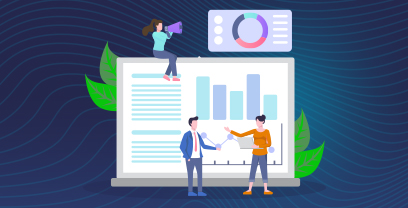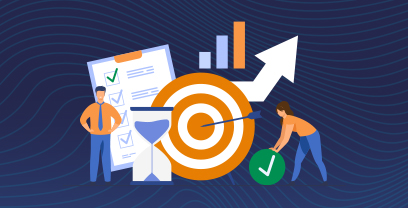Enterprise procurement teams face growing pressure to deliver strategic value – managing supplier risk, ensuring compliance, and supporting sustainability – all without sacrificing speed or control.
Unfortunately, outdated tools and fragmented processes make it difficult to maintain visibility across the supply chain and adapt at the pace of business.
This blog explores the most common challenges in digital procurement and the capabilities that matter most. Drawing on real-world use cases and proven frameworks, we highlight what separates high-performing teams from the rest, and how to build a foundation for smarter, more agile procurement.
Key Takeaways
- Legacy procurement processes limit scale, speed, and visibility, making it harder to manage risk, compliance, and costs.
- Digital procurement streamlines workflows and unifies data, enabling faster sourcing, better collaboration, and improved accuracy.
- AI and automation boost procurement’s strategic impact, helping teams reduce risk, ensure compliance, and forecast spend.
- A staged maturity model guides transformation, helping organizations prioritize high-impact improvements and scale over time.
Learn how Ivalua can help you on your journey to digital procurement.
Explore Platform | Find Out More
What Is Digital Procurement?
Before organizations can fully benefit from agility and automation, it’s important to understand the concept of digital procurement. Digital procurement is the use of digital technologies to enhance, automate, and optimize procurement processes across the entire source-to-pay (S2P) lifecycle.
This includes leveraging tools such as digital sourcing platforms, eprocurement software, contract lifecycle management (CLM), supplier management, data analytics, and artificial intelligence (AI) to streamline procurement operations.
Digital procurement replaces manual, and siloed systems with automated processes that provide real-time visibility and improve accuracy. They increase an organization’s efficiency during processes like sourcing, purchasing, supplier management, and spend analysis.
Digital procurement enables smarter, data-driven decision-making and the ability to integrate with ERP, finance, and supply chain systems to streamline operations.
How Digital Procurement Differs from Traditional Procurement
Traditional procurement often relies on manual processes, siloed systems, and paper-based workflows that can result in errors and delays, and limit visibility into spend and supplier performance. Sourcing, approvals, and contract management work is inefficient and typically requires more time and resources.
Digital procurement automates these activities, streamlining the various processes across source-to-pay to reduce cycle times and administrative overhead. It also enables a proactive approach to managing supplier relationships using supplier portals and scoreboards, collaboration tools, and predictive analytics using AI-powered tools.
All of this enhances procurement efficiency and enables cost optimization.
Why Digital Procurement Matters for Enterprises
As organizations scale, manual procurement processes and disconnected systems create inefficiencies, compliance gaps, and limited visibility into supplier risk and overall spend
Digital procurement platforms can address these challenges by automating routine tasks and standardizing workflows across multiple systems such as ERP and SRM solutions, eliminating data silos to improve governance and support better decision-making across the enterprise.
Procurement technology helps lean teams scale efficiently so they can manage more spend, suppliers, and categories effectively, and still maintain control. Automation streamlines approvals, contracts, and onboarding, while embedded compliance and supplier risk tools help to reduce errors and flag issues early.
Today, Generative AI is expanding the impact of procurement even more. For example, Ivalua’s Intelligent Virtual Assistant (IVA) can draft RFPs, summarize supplier data, research categories, and handle various intake requests via chat, helping to transform procurement into a more strategic function.
Digital Procurement Use Cases by Function
Let’s take a closer look at how digital procurement technology can be leveraged by multiple teams and functions across the enterprise.
Procurement Teams
Digital technology empowers procurement teams with efficiency and control. It acts as a springboard to accelerate sourcing and RFx processes through automated workflows, reverse auctions, and configurable e-RFQs.
Contract drafting and approvals can be streamlined with predefined workflows and clause libraries, reducing legal review time while still maintaining compliance.
Vendor master data governance becomes more manageable; centralized supplier records, automated validations, and integrations ensure accuracy and eliminate duplicate work, speeding up digital supplier onboarding.
Finance Teams
With spend analytics integrated directly into the procurement process, finance professionals can monitor purchasing against budgets in real time, ensuring greater accountability and fewer surprises at the end of the quarter.
Additionally, automated invoice matching and payment workflows improve touchless processing speed and accuracy, and provide a level of visibility into upcoming spend commitments and invoice cycles that improves cash flow forecasting.
Legal and Compliance
By embedding intelligent controls throughout the contract lifecycle. AI-powered procurement systems can automatically score contracts for risk based on clause language, supplier profile, and contract value.
They can flag non-standard clauses automatically for legal review, eliminating the need for manual reviews of every contract. Teams can consistently enforce policy compliance across global teams, reducing exposure and improving audit readiness.
Download our “Digital Procurement Transformation Checklist” to learn how to get started.
Key Enterprise Challenges in Digital Procurement
As enterprise procurement teams take on broader strategic responsibilities, they face a new generation of challenges – from managing supplier risk to navigating compliance and integrating with aging IT infrastructure.
AI and predictive analytics have delivered powerful new capabilities – but they’ve also increased expectations for real-time insight, intelligent automation, and seamless system interoperability.
In this section, we’ll break down some of the new challenges enterprises are facing, and why the complexity of modern procurement demands advanced digital capabilities with procurement automation.
Scaling Procurement Operations without Losing Control
As enterprises expand globally and manage more categories, suppliers, and spend, maintaining control with more and more uncertainty in global markets becomes a growing concern.
Disconnected systems and inconsistent processes can lead to incomplete or fragmented spend and supplier information, not to mention limited visibility across business units, This complicates policy enforcement and negotiations, leading to inconsistencies.
Managing Compliance and Regulatory Complexity
Global procurement teams must stay ahead of ever-changing laws and regulations – ESG requirements, trade restrictions, tariffs, and industry-specific regulations, and more.
They must be able to enforce internal policies and monitor third-party compliance in real time, as well as respond quickly to audits or investigations, without slowing down operations.
Reducing Supplier Risk while Maintaining Efficiency
Tracking rising geopolitical, environmental, and financial risks manually across a global supplier base is not just time-consuming – it’s impractical and perhaps impossible. Procurement leaders need a smarter way to assess supplier viability, identify early warning signs, and act before disruptions impact the business.
Integrating Procurement with Legacy ERP and Supply Chain Systems
Enterprises often operate with multiple, aging ERP systems and disconnected procurement and supply chain platforms – and that makes it hard to introduce modern systems and tools without creating silos or duplicating data.
Any new solution must integrate easily into the existing tech stack, while supporting end-to-end visibility and collaboration.
Achieving Real-time Visibility into Procurement Data
If you don’t have a unified view of data and activity across sourcing, contracts, suppliers, and spend, you’ll constantly struggle to make timely, informed decisions.
Real-time visibility is essential – not just for tracking procurement KPIs, but also for access to the predictive insights and agility today’s businesses demand.
While these challenges may seem overwhelming, digital procurement technology is built to solve. In the next section, we’ll explain how.
Essential Digital Procurement Features that Solve these Challenges
Based on interviews with over 380 procurement leaders, Ardent Partners projects that by the end of 2024, 74% of Chief Procurement Officers will have adopted Generative AI to drive procurement automation, improve decision-making, and elevate the user experience. And that’s just one of the capabilities digital procurement enables.
Increasingly, top-performing enterprises are adopting procurement technology platforms with advanced capabilities that help transform procurement into a strategic business function.
Let’s take a look at how Ivalua’s procurement platform delivers on the promise of digital procurement.
Source-to-Pay (S2P) Platforms for Centralized Procurement
To manage procurement at scale, enterprises need end-to-end visibility and control across the Source-to-Pay lifecycle. A centralized S2P platform consolidates workflows and data across sourcing, contracting, purchasing, invoicing, and supplier management into a single, unified system.
This eliminates process silos, improves data accuracy, and accelerates procurement cycles across global business units.
Ivalua’s Source-to-Pay platform is purpose-built for the enterprise, providing a seamless user experience across the entire procurement lifecycle while integrating easily with ERP and supply chain systems.
This makes it easier to scale, standardize, and innovate without compromising flexibility. Organizations are able to start in one process area such as supplier information management or sourcing and grow from there.
Download our Intake Management Datasheet to learn how Ivalua’s no-code/low-code, AI-powered platform can modernize how employees engage in procurement processes from intake to pay and have a simple and collaborative experience
AI-Powered Automation for Compliance and Risk Management
Manual compliance checks and reactive assessments leave enterprises exposed to risk. On the flipside, automation ensures consistent policy enforcement and proactive risk mitigation without slowing down procurement activity. AI enhances this by helping to identify anomalies, surface risks earlier, and streamline intake and approval workflows.
For example, thanks to Ivalua’s AI-powered procurement platform, organizations can route requests, apply policy rules, and validate vendor data automatically. They can also leverage built-in risk models and configurable compliance controls to meet regulatory requirements.
Supplier Collaboration and Performance Management Tools
Managing growing supplier networks requires more than transactional relationships. Enterprises need visibility into supplier performance, risk, and ESG metrics—alongside the tools to engage and collaborate effectively.
Ivalua’s Supplier Management software capabilities support centralized onboarding, real-time risk and performance scorecards, and shared portals that enable two-way communication. These tools help improve supplier accountability, accelerate onboarding, and align vendors with enterprise values and standards.
Multi-ERP and System Integration Capabilities
Enterprises often operate with multiple ERPs and legacy systems across regions or business units. A digital procurement platform must integrate seamlessly with this environment to avoid data silos, duplicated effort, and fragmented processes.
Ivalua’s Multi-ERP integration capabilities allow you to easily connect procurement activities across disparate systems, delivering a consistent user experience with access to centralized data and unified reporting.
Advanced Analytics for Procurement Insights and Forecasting
Traditional reporting falls short when it comes to forecasting demand, identifying cost-saving opportunities, or tracking compliance across thousands of transactions.
With Ivalua Spend Analysis, you gain access to real-time dashboards, category insights, supplier benchmarks, and AI-powered forecasts. You can drive value creation and support strategic sourcing while proactively managing risk.
Learn how Ivalua’s unified Source-to-Pay Platform can help your organization increase agility, reduce risk, and gain complete control over procurement at scale.
How to Start Your Digital Procurement Journey
Achieving digital procurement transformation is a step-by-step process; organizations evolve through distinct stages of digital maturity.
Ivalua’s digital procurement maturity model can help you map where you are today, where you need to go, and what steps to take to get there. It can also help you align your investments with overall business objectives.
Teams stuck in early stages of procurement maturity often grapple with inefficiencies, poor visibility, and disconnected tools. Once your processes are unified, automated, and enhanced by AI, you can unlock cost-savings, reduce risk, and become far more strategic in your supplier relationships and decision-making.
In this section, we’ll provide an overview of the maturity model and an action plan for progress.
Maturity Model Overview
Stage 1: Manual & Reactive
At this stage in the model, your Procure-to-Pay solution may rely heavily on spreadsheets, emails, and paper-based processes. There’s minimal visibility into spend, and teams are constantly putting out fires rather than driving value. Compliance and risk are hard to monitor, and strategic planning is nearly impossible.
Stage 2: Fragmented Digital Tools
Organizations begin using procurement software for sourcing, contracts, or invoicing, but these tools operate in silos. While there is some efficiency, a lack of integration leads to data inconsistencies, limited automation, and disjointed processes, making insights difficult to obtain.
Stage 3: Unified Digital Workflows
Procurement processes are connected across the source-to-pay lifecycle through a centralized platform, providing real-time visibility, standardized workflows, and improved compliance. Supplier management and performance tracking are more structured and proactive.
Stage 4: Predictive & AI-Enabled Procurement
Machine learning and AI in procurement are used to derive predictive insights, auto-draft sourcing documents, and flag supplier risks before they occur. Procurement becomes a true business partner that’s agile, data-driven, and aligned with corporate goals (ESG, resilience, procurement innovation, etc.).
Action Plan for Progress
While the stages are clear, progressing from one stage to the next may require further explanation. Here’s a plan of action for success:
- Run a Digital Maturity Assessment: Before making any investments, assess where your organization currently stands. Is there a need for optimizing the procurement process or tech stack? What about the quality of your data?
Many platforms, including Ivalua, offer frameworks or tools to help benchmark your maturity level and set realistic goals.
- Prioritize High-Impact Use Cases: Focus on the areas in which digital procurement can deliver immediate value (for example, spend visibility, invoice automation, or supplier risk tracking). Quick wins build momentum and help you secure buy-in.
- Build the Internal Business Case: Communicate how digital procurement supports enterprise goals such as cost reduction, risk mitigation, and ESG performance. Quantify the opportunity with real-world KPIs (reduction in cycle time, increase in spend under management, etc.) and align your case with finance, legal, and operations leaders.
- Choose a Scalable Platform: Select a procurement solution that not only meets current needs but will evolve with your organization. Ivalua’s Source-to-Pay platform supports growth at every stage of the maturity model, with built-in flexibility to integrate with legacy systems and scale AI capabilities over time.
Explore the Source-to-Pay Technology Buyer’s Guide to evaluate your options and select a platform built for long-term transformation.
Find out how Ivalua’s no-code/low-code AI-powered Procurement platform could transform your procurement operations with our Procurement Platform Datasheet.
Customer Story: Rogers Communications Streamlines $6B in Spend with Ivalua
How did a leading Canadian communications and media company transform their procurement processes into a strategic, data-driven function amid cost pressures, limited resources, and post-pandemic disruptions?
By implementing Ivalua’s unified platform, Rogers Communications replaced seven disconnected systems, streamlined operations, and shifted to a self-service model.
The result? Less reactive work, more spend under management, and stronger analytics to guide decisions. Even with a leaner team, procurement now manages $6 billion in spend with greater speed, visibility, and control.
We have successfully moved towards a digitally enabled self-service model, allowing Procurement to focus more on strategic and high-value activities. Ivalua has allowed us to improve user experience, drive efficiencies and consolidate activities under a single platform.
– Vijay Jainaraine Director for eProcurement and Analytics RogersRead the full Rogers Communications case study.
Elevate Procurement with Integrated, Intelligent Technology
As with the customer story above, with procurement evolving into a more strategic function, the need for unified, intelligent platforms has never been greater. By investing in digital procurement solutions like Ivalua, enterprises can streamline operations, manage risk, and gain the agility they need to respond to shifting market dynamics.
Whether you’re just beginning your digital journey or advancing toward predictive, AI-powered capabilities, the right technology can turn procurement into a true source of competitive advantage.
Learn more about Ivalua’s unified platform or contact us today to get started:
FAQs about Digital Procurement
How is digital procurement different from e-procurement?
Digital procurement goes beyond e-procurement by integrating the entire source-to-pay process, including analytics, supplier management, risk mitigation, and AI-driven insights. While e-procurement typically focuses on purchasing transactions, digital procurement enables strategic decision-making and enterprise-wide visibility.
What ROI can I expect from digital procurement?
Enterprises typically see ROI through reduced cycle times, increased spend under management, improved compliance, and lower total cost of ownership. Additional value comes from better supplier performance, risk mitigation, and greater alignment with business goals.
What tools are essential for digital procurement?
Key tools include spend analysis, e-sourcing, contract lifecycle management, supplier risk and performance tracking, and procurement automation. Integration with ERP systems and AI-powered analytics are also critical for driving long-term strategic value.




